The third and final day of concerts at Dark Music Days began with Guðný Einarsdóttir presenting a survey of composer Jón Nordal’s complete organ works in Reykjavík Cathedral, a stately construction built at the end of the 18th century. Born in 1926, Nordal (who was in attendance) is one of Iceland’s most recognized and independent musical figures, and his organ works—laden with liturgical symbolism and referents—are closely tied to the cathedral itself; each work is dedicated to the different church organists who have been part of the community throughout Nordal’s life. Proceeding in chronological order, formal schemes and sonorities became more and more polytonal and episodic, giving way to many contemplative journeys. Einarsdóttir handled the mystical terrain of these meandering harmonies with a great sense of rhythm and preparation, the full and rich sound of this triple-manual organ with thirty one independent voices resounding as if it was clearing the morning clouds, welcoming the afternoon sun.
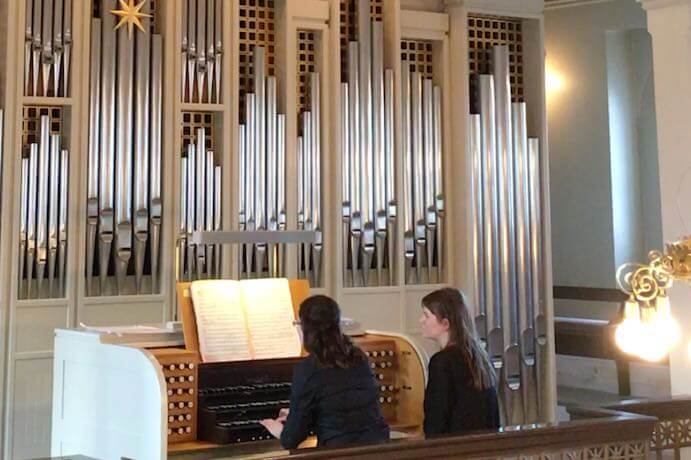
Following this moving morning concert, cellist Guðný Jónasdóttir delivered a fierce performance of gripping new Icelandic music back at Harpa, in the Kandalón hall. Performing works by Helgi R. Ingvarsson, Hugi Guðmundsson, Hafliði Hallgrímsson, and Halldór Smárason, Jónasdóttir demonstrated absolute command of her instrument and of her own ability to follow each sound to its logical end. Hugi Guðmundsson’s Alluvium was for amplified cello and indulged in wonderful percussive effects and vertical bowing which would generate echoes in the electronics’ delay formula. In Hafliði Hallgrímsson’s Solitaire, expressive and melodic double-stops slid up and down in all different positions and in and out of quarter tones. A pastorale, played senza vibrato, led into arpeggiations which grew more and more intense with figures hanging in a delicate balance, moving into harmonies which then disappeared completely in the upper register. Halldór Smárason’s multi-movement Pólypsar contained many fascinating traits from the abstract moving lines with simultaneous left hand pizzicato to a non-bowed and all-plucked gypsy-like pizzicato etude. It ended with lively rhythmic vitality, using rapid up/down bows with full range glissandos and open string arpeggiation.
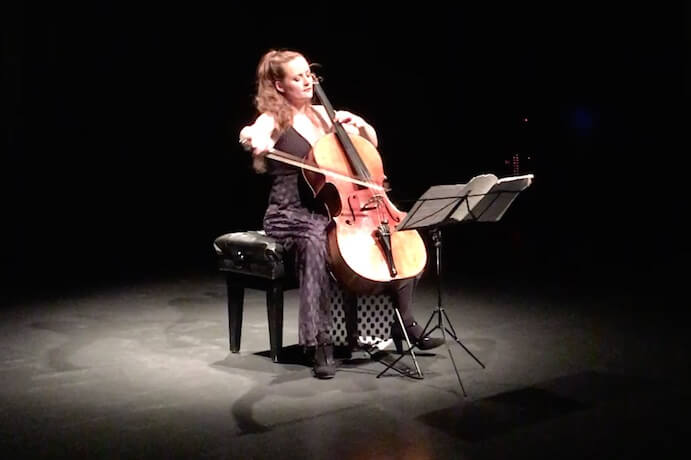
Nordic Affect, a quintet comprised of five women devoted to an amalgamation of historically-informed period instrumental practice and new music, gave one of the most inspired performances here at Dark Music Days. With a program of works all written within the last two years from Swedish, English, and Icelandic composers– the majority of them women– here was the essence of what Artistic Director Þórunn Gréta Sigurðardóttir envisioned as the onus of this year’s festival: towards the transformation of prevailing attitudes and by addressing issues of representation that women are rightfully expected to receive in their chosen fields. Here was an ensemble at the height of their powers presenting equally rigorous music with exceptional clarity and conviction.
Beginning with Mirjam Tally’s piece, Warm life at the foot of the iceberg for string trio and harpsichord, preoccupations with color predominated with scrape tones and circular bowing in the strings and clusters on the harpsichord periodically interjecting into the texture. Violinist Halla Steinunn Stefánsdóttir’s at times whistling tone seemed to evoke the wind whistling between rooftops, and each player handled complex timings with interpretive ease. Hildur Guðnadóttir’s Point of Departure took the entire ensemble and made it function as a single voice. Amplified and shrouded in darkness, each player vocalized and whispered while cellist Hanna Loftsdóttir gracefully played a duet with the harpsichord over the violin and viola’s string harmonics, everyone playing in a uniform rhythm together. Anna Þorvaldsdóttir’s Impressions for solo prepared-harpsichord offered an opportunity for Guðrún Óskarsdóttir to explore her instrument from new vantages. As she walked around the instrument casting rubber balls on top of the strings, triggering small resonators, and strumming with her hands, she created a bountiful variety of sound and events.
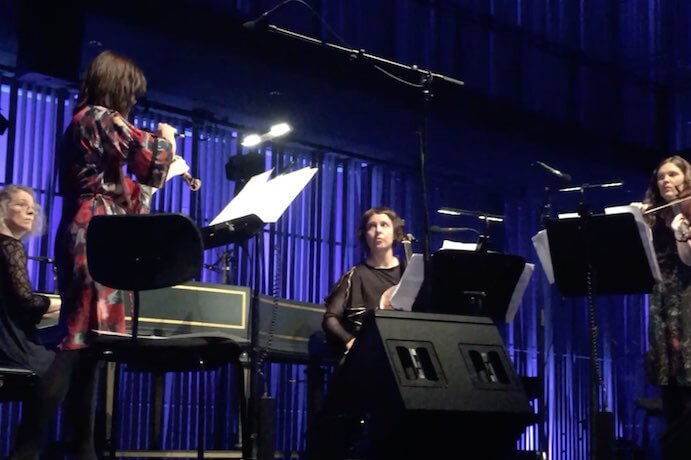
Afterwards, Georgia Browne, playing the Traverso (wooden keyless flute often referred to as a baroque flute) gave a heartwarming rendition of Rachel Stott’s solo piece The Dancing of the Sunbeams, recalling a sentimental imaginary past inspired by Jonathan Swift’s Gulliver’s Travels. Þráinn Hjálmarsson’s Lucid/Opaque for string trio contained beautiful meditative stillness; a glacial gravitas unfolding on the knife-edge of complete silence. In María Huld Markan Sigfúsdótirr’s Spirals, the trio produced a dizzying array of harmonics over an electronic texture which gradually invoked a percussive feel. It ended in incredibly long tones, perfectly placed and drawn out, Guðrún Hrund Harðardóttir’s viola soaring in its stillness, completing the circle back into captivating silence.
Violin soloist Hlíf Sigurjónsdóttir’s concert contained some of the most adventurous and abstract music of Dark Music Days. Opening with Rúna Ingimundar’s Away from home, she tapped into the authentic cultural landscape; these pieces are like theme and improvisations based on Icelandic folk songs from the so-called kvæðalög. Sigurjónsdóttir played these very personal pieces from memory. Hróðmar Ingi Sigurbjörnsson’s Kyrie was more animated with interesting intervalic hinges. Karólína Eiríksdóttir’s Meditation for Solo Violin was a slow and expressive journey that showcased Sigurjónsdóttir’s mastery of the extreme upper register. American composer Merrill Clark’s piece The Sorceress, a multi-movement work written for Sigurjónsdóttir, brought the program into furious overdrive. During The Sorceress, in which Clark’s whimsical and intricate take on Baroque dance-structures produced hazardous virtuosic expression, a huge 20×20 foot backdrop displayed Greek artist Ektoras Binikos’ psychedelic visual landscapes of fractal universes and Fibonacci spirals, sending the neocortex into swirling kaleidoscopic metamorphoses. This engaging and challenging work was a fantastic glimpse into some far away future.
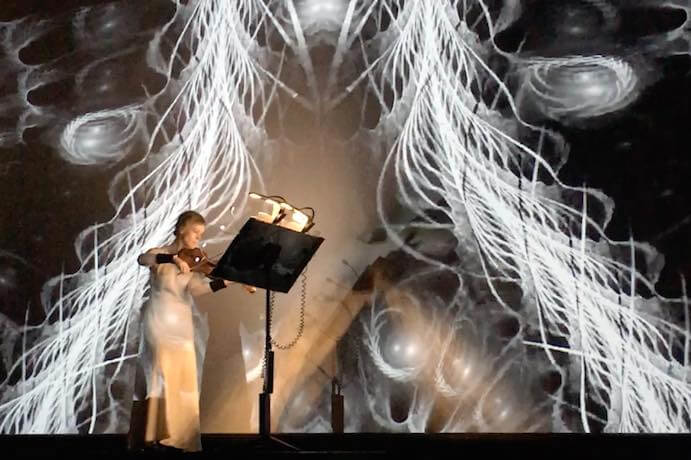
Lastly, the Vox feminae & Aurora choirs and the Reykjavík Chamber Orchestra– two separate concerts which were captivating in different ways– closed the festival. The conjoined angelic voices of the choirs sang in the open spaces of Harpa itself, filling the entire structure with beauty. Conductor Margrét J. Pálmadóttir led them finally into a locative stream of an improvised piece as they descended a stairway away from onlookers. The Reykjavík Kammersveit focused their energies on the work of Atli Heimir Sveinsson, whose music demanded careful attention for its remarkable, otherworldly style. They also gave a rendition of the curious and challenging Pattern IIb by Gunnar Andreas Kristinsson, for xylophone, marimba, vibraphone, and winds.
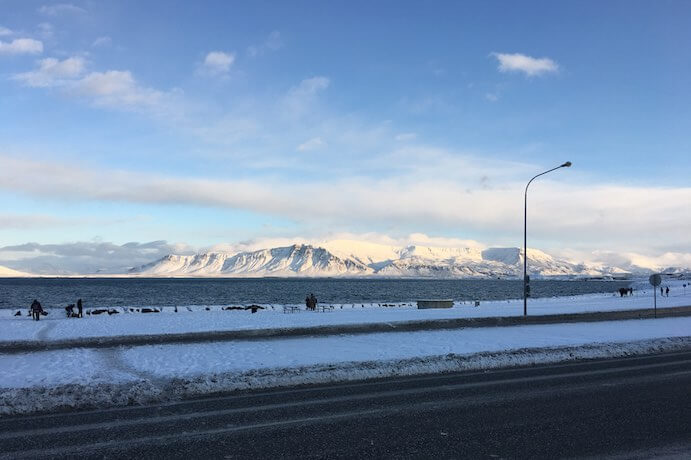
As this saga came to a close, there was the presence of the snow-covered Esja mountain, a spiritually significant point of camaraderie amongst the people of Reykjavík, and it seemed to be conveying in its majestic silence an idea Albert Camus once articulated: “In the midst of winter, I finally learned that there was in me an invincible summer.” Indeed, inside each of the composers, performers, and organizers here at Dark Music Days could be glimpsed this invincible summer, with all its radiance.
























